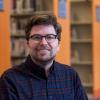Posted by Jason on Thursday, Oct 2, 2014
David Mitchell is my favorite writer and I was so excited for this book to arrive. Like many of his earlier books (Ghostwritten, Cloud Atlas) this is another novel broken up into novellas/chapters focusing on different characters that are interwoven to create a more nuanced tale. This changing point of view can be tricky because just as you find yourself settling in with a character it ends and you’re shuttled off a decade in the future and a different setting. I thought it worked so well in Cloud Atlas, possibly because he brought us back to the characters through the second half of the book but probably more that it read like an audacious novel puzzle. In The Bone Clocks I thought at least three of the stories either weren't necessary or just lacked the payoff he meant them to have.
The story mostly follows a path around the life of Holly Sykes, beginning with her angsty teenage years living above a pub with her raucous family and ending in a all-too-believable post-climate change crash Ireland. Her brother vanishes early-on and she finds out it is probably a supernatural kidnapping. She soon encounters various people that are sort of immortal, they are being reborn into new bodies but retain prior knowledge. They are secretly battling another form of predatory immortals who have devised a way to harvest innocent souls in a special ancient church to grant extended life.
Despite my reservations about some of the chapters, Mitchell remains a master of language and character building. There are many positive reviews out there for this novel (and a 2014 Man Booker Prize longlist nod) so it’s probably one to try if you’re a fan of Mitchell’s earlier books. If you’re new to him, I would instead recommend the classic Cloud Atlas.


Autobiographical stories of his work as Tropical Senior Botanical Horticulturist for the Royal Botanic Gardens at Kew, England. Carlos describes coming from a family that encouraged exploration, as well as respect and caretaking for the plants and animals of Asturias in Northern Spain. When wanderlust overtook him at 28, he travelled to London where a trip to the Royal Botanic Gardens of Kew changed his world. Their efforts to save highly endangered plants mirrored his passion for caring for the land back in Asturias. He has an energetic, driven personality that comes through in his recounts of his intense Kew education in the greenhouses and beyond. Most of the book recounts his journeys to save seeds or cuttings of rare plants found in the islands of the Republic of Mauritius in the Indian Ocean, Amazon backwaters in Peru, and many other far flung locations. He’s a great storyteller and has set up each chapter as if he has to solve a puzzle with life or death stakes, how do these rare plants produce fruit, seed, and ultimately a new plant? He includes simple overviews of the science behind his a-ha moments, so even if you don’t have a botanical background you come away with an understanding for how these mysteries were solved. His passion for plants is infectious and it carries through in his writing, the stories are often zany and move quickly and you’re left feeling that we need many more people with the drive and desire of this plant messiah. -Jason